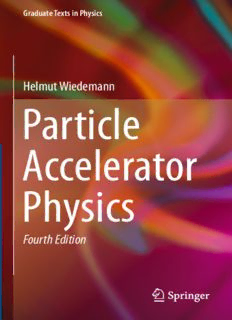
Particle Accelerator Physics PDF
Preview Particle Accelerator Physics
Graduate Texts in Physics Helmut Wiedemann Particle Accelerator Physics Fourth Edition Graduate Texts in Physics SeriesEditors SadriHassani Illinois,USA W.J.Munro Kanagawa,Japan RichardNeeds Cambridge,UK WilliamT.Rhodes Florida,USA MartinStutzmann Garching,Germany AndreasWipf Jena,Germany GraduateTexts inPhysics Graduate Texts in Physics publishes core learning/teachingmaterial for graduate- andadvanced-levelundergraduatecoursesontopicsofcurrentandemergingfields within physics, both pure and applied. These textbooks serve students at the MS- or PhD-level and their instructors as comprehensive sources of principles, definitions,derivations,experimentsandapplications(asrelevant)fortheirmastery and teaching, respectively. International in scope and relevance, the textbooks correspondtocoursesyllabisufficientlytoserveasrequiredreading.Theirdidactic style, comprehensiveness and coverage of fundamental material also make them suitable as introductions or references for scientists entering, or requiring timely knowledgeof,aresearchfield. Moreinformationaboutthisseriesat www.springer.com/series/8431 Helmut Wiedemann Particle Accelerator Physics Fourth Edition 123 HelmutWiedemann EmeritusProfessorofAppliedPhysics andoftheStanfordSynchrotron RadiationLaboratory StanfordUniversity Stanford California,USA ISSN1868-4513 ISSN1868-4521 (electronic) GraduateTextsinPhysics ISBN978-3-319-18316-9 ISBN978-3-319-18317-6 (eBook) DOI10.1007/978-3-319-18317-6 LibraryofCongressControlNumber:2015945573 SpringerChamHeidelbergNewYorkDordrechtLondon ©SpringerInternationalPublishingSwitzerland1993,1999,2007,2015 Thisworkissubjecttocopyright.AllrightsarereservedbythePublisher,whetherthewholeorpartof thematerialisconcerned,specificallytherightsoftranslation,reprinting,reuseofillustrations,recitation, broadcasting,reproductiononmicrofilmsorinanyotherphysicalway,andtransmissionorinformation storageandretrieval,electronicadaptation,computersoftware,orbysimilarordissimilarmethodology nowknownorhereafterdeveloped. Theuseofgeneraldescriptivenames,registerednames,trademarks,servicemarks,etc.inthispublication doesnotimply,evenintheabsenceofaspecificstatement,thatsuchnamesareexemptfromtherelevant protectivelawsandregulationsandthereforefreeforgeneraluse. Thepublisher,theauthorsandtheeditorsaresafetoassumethattheadviceandinformationinthisbook arebelievedtobetrueandaccurateatthedateofpublication.Neitherthepublishernortheauthorsor theeditorsgiveawarranty,expressorimplied,withrespecttothematerialcontainedhereinorforany errorsoromissionsthatmayhavebeenmade. Printedonacid-freepaper Springer International Publishing AG Switzerland is part of Springer Science+Business Media (www.springer.com) To mysonsandstudents Preface to Fourth Edition Just 20 years have passed since the first edition. During those years, the book has gone through several phases starting with the two volume edition 1 and 2. Finally in 2007, both volumes and the book on SynchrotronRadiation have been combinedintotheThird-Editionasonevolumetoserveasatextbookforstudents andbeginnersaswellasareferencebookforthepractitioners.Nowithasbecome necessaryto reviewthetextandupgradeto includenewdevelopments.Italso has become apparentthat the decision for the Third-Edition to eliminate introductory accelerator physics was not correct. Use of this text for beginners is quite broad, and the introduction to accelerator physics is desired. Therefore, three chapters have been added at the beginning to introduce a variety of accelerators and their functioning.Insupporttoteaching,manyproblemswithsolutionshavebeenadded forthosechapters.Theauthoralsotriedtodistinguishbetweenintroductorychapters andchapterswhichleadtomoredetailedsubjectsandshowproofs.Chapterswhich canbeskippedonafirstreadinghavebeenlabeledwithastar(cid:2): Asmentioned,thetextincludesmanyproblemswithandwithoutsolutions.The idea was to give solutions for the beginners while more advanced problems are not suitable for solutions in a textbook. Accelerator physics is not a collection of homework problems. Many questions and problems are rather complex and need to be treated in context with their impact on other systems. In most cases, thereisnooneoptimumsolution.Individualparameterchoicesmustbemadeand modified according to their impact on other systems. Choices in beam dynamics, for example, have an impact on magnet design or RF-system parameters, etc. affectingthe design of power suppliesor financialbudget. Straightforwarddesign choicespermeatethroughalmostallothercomponentsrequiringcarefulevaluation. Often the consequence of one parameter choice on other systems will become apparent only after considerable further design optimization. Unfortunately,often compromisesmustbemadebecauseoffinancialconsiderations.Workinaccelerator physicsincludesoftenseveralapproximations,andthedesignershouldnothesitate tostartoveragainwithnewinsight.Allthiscannotbeincludedinproblemsolutions inatextbook.However,itseemedtotheauthorinterestingtothrowupsuchdesign problemswhichtheinterestedreadercanusetomakehis/herchoices. vii viii PrefacetoFourthEdition Finally,inthelastchapteronFreeElectronLasers,ashortintroductionintothe componentsofa SASE-FEL facility is given.Thisintroductionmustbe shortand limited to the discussion of issues and function of main components in this text. Muchmoredetailis requiredto designsuch a facility anda dedicatedtextbookis desirable. I would like to thank all staff at Springer Publishing, especially the Editor Dr. ChristianCaron,ProductionCoordinatorMrs.BirgitMuench,theProductionEditor andManagerMs.ShanthiRamamoorthy,andMs.FathimaRizwanafortheircareful editing,support,andhelpbeforeandduringtheproductionprocess. ChiangMai,Thailand HelmutWiedemann February,2015 Preface to Third Edition ThisissueofParticleAcceleratorPhysicsisintendedtocombinethecontentoftwo earlier volumesand the volumeon synchrotronradiationinto onereferencebook. Thisbookisdesignedfortheseriousscientistandstudenttoacquiretheunderlying physics of electron accelerator physics. Introductorydiscussions on various types ofacceleratorshavebeeneliminated,beingwelldocumentedintheliterature.Beam opticshasbeenformulatedinageneralwayastobeapplicablealsotoprotonandion beams.Followingtherequestsofmanyreadersmanysolutionstoexercisesaregiven intheAppendix.Breakingwiththeauthor’spreference,StandardInternationalunits are used in this edition. In Appendix B, transformation rules are given to convert formulaebetweenSIandcgssystems.Intheprocessofrewritingthetexts,known typographicalandrealerrorshavebeencorrected.Theauthorwishestoexpresshis sincereappreciationtoallreaderspointingoutsucherrors. IwouldliketothankallstaffatSpringerwhohavecontributedtothepublication ofthistext.Foremost,IthankDr.ChristianCaronforhissuggestionandencourage- menttocombineseveraltextbooksintoonereferencevolume.Fortheexpertediting andcoverdesignIthankMrs.BirgitMuenchandherstaff.Finally,itisapleasureto thankMs.BhawnaNarangfromTechbooksforherpatientandthoroughpreparation oftheproofsandfinalprinting. NakhonRatchasima,Thailand HelmutWiedemann March2007 ix
Description: